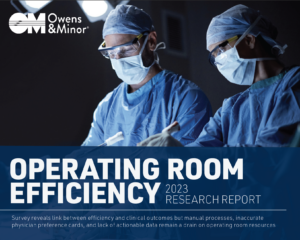Perioperative Leaders Say They Have Data; What They Need Are Actionable Insights
A new survey of 250 Perioperative leaders, conducted by the Association of periOperative Registered Nurses (AORN) and commissioned by Owens & Minor, found greater operating room (OR) efficiency correlates to better patient outcomes.
The research gathered insights on Perioperative team’s use of data to improve process efficiency related to four key performance indicators (KPIs): On-time starts; starts within the target turnover time; percentage of OR utilization; and case pick accuracy.
The survey asked respondents how helpful was their data in drawing conclusions about the efficiency of their OR. The survey findings clearly show OR teams with “helpful” data use it more frequently to drive efficiency and have greater success in their initiatives.
The research revealed a distinct link between the helpfulness of data and one of the four KPIs studied: OR utilization rate. Perioperative leaders who perceive their data as “extremely helpful” have 75% OR utilization while those who perceive it as “not at all helpful” have only 49% utilization.
Honing In On The “Holy Grail” of OR Costs
Hospitals must break through disjointed system silos and integrate supply costs, clinical outcomes, and financial data.
Faced with growing financial pressures, a strategic priority for Perioperative leaders is to determine the true total cost of surgical procedures. With supplies representing the second largest area of expense, behind labor, understanding how product choices impact total case costs and reimbursement is critical to making fiscally responsible decisions.
But those surveyed say they rarely use available data to determine case cost per procedure (seven times per year on average) or compare cost variance between surgeons (three times per year on average). The research findings indicate that while Perioperative leaders know what products are on their physicians’ preference cards, they lack “helpful” data around supply consumption and overall costs.
The move toward a more integrated supply chain, as defined by the Association for Healthcare Resource and Materials Management (AHRMM), means hospitals must break through disjointed system silos and integrate supply cost, clinical outcomes, and financial data (e.g., total case cost, reimbursement). Only with accurate, meaningful, and timely analytics can they transition from pure preference to evidence-based supply decisions.
How To Establish A Data Source Of Truth
Perioperative leaders need a solution that proactively pushes timely, relevant, and actionable insights.
Owens & Minor QSight® is a fully integrated, cloud-based, digital supply chain solution that leverages artificial intelligence (AI) for data analysis based on an OR’s supply chain, clinical documentation, and financial data.
The solution features automated product data capture at the point of use (POU) via barcode scanning and physician preference card management to provide OR teams with predicative analytics based on supply consumption and procedural volume trends over time. Complete and timely insights are reported graphically so they are easy to understand, helping Perioperative leaders take immediate action to improve key efficiency KPIs.
Looking For More Of The Latest Trends In OR Efficiency?
The 2023 Owens & Minor Operating Room Efficiency Research Report presents key findings from the survey of 250 Perioperative leaders. This report offers quantitative insights into how efficiency in an OR correlates to patient outcomes and drills down into specific factors that generate unnecessary labor, costs, and waste.


















